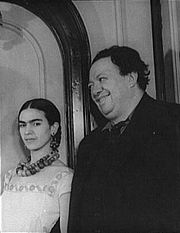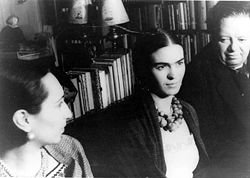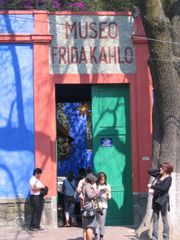Frida Kahlo
2008/9 Schools Wikipedia Selection. Related subjects: Artists
| Frida Kahlo | |
 Frida Kahlo, Self-portrait with Thorn Necklace and Hummingbird, Nikolas Muray Collection, Harry Ransom Centre, The University of Texas at Austin |
|
| Birth name | Magdalena Carmen Frida Kahlo y Calderón |
| Born | July 6, 1907 Coyoacán, Mexico |
| Died | July 13, 1954 (aged 47) Coyoacán, Mexico |
| Nationality | Mexican |
| Field | Painting |
| Training | Self–taught |
| Movement | Surrealism |
| Works | in museums:
|
| Patrons | and friends:
|
Frida Kahlo (July 6, 1907 – July 13, 1954) was a Mexican painter, who has achieved great international popularity. She painted using vibrant colors in a style that was influenced by indigenous cultures of Mexico as well as by European influences that include Realism, Symbolism, and Surrealism. Many of her works are self-portraits that symbolically express her own pain and sexuality.
In 1929 Kahlo married the Mexican muralist Diego Rivera. They shared political views, and he encouraged her artistic endeavors. Although she has long been recognized as an important painter, public awareness of her work has become more widespread since the 1970s. Her "Blue" house in Coyoacán, Mexico City is a museum, donated by Diego Rivera upon his death in 1957.
Childhood and family
Magdalena Carmen Frida Kahlo y Calderón, as her name appears on her birth certificate was born on July 6, 1907 in the house of her parents, known as La Casa Azul (The Blue House), in Coyoacán. At the time, this was a small town on the outskirts of Mexico City.
Her father, Guillermo Kahlo (1872-1941), was born Carl Wilhelm Kahlo in Pforzheim, Germany. He was the son of the painter and goldsmith Jakob Heinrich Kahlo and Henriett E. Kaufmann. Kahlo claimed her father was of Jewish and Hungarian ancestry, but a 2005 book on Guillermo Kahlo, Fridas Vater (Schirmer/Mosel, 2005), states that he was descended from a long line of German Lutherans . Wilhelm Kahlo sailed to Mexico in 1891 at the age of nineteen and, upon his arrival, changed his German forename, Wilhelm, to its Spanish equivalent, 'Guillermo'. During the late 1930s, in the face of rising Nazism in Germany, Frida acknowledged and asserted her German heritage by spelling her name, Frieda (an allusion to "Frieden", which means "peace" in German).
Frida's mother, Matilde Calderón y Gonzalez, was a devout Catholic of primarily indigenous, as well as Spanish descent. Frida's parents were married shortly after the death of Guillermo's first wife during the birth of her second child. Although their marriage was quite unhappy, Guillermo and Matilde had four daughters, with Frida being the third. She had two older half sisters. Frida once remarked that she grew up in a world surrounded by females. Throughout most of her life, however, Frida remained close to her father.
The Mexican Revolution began in 1910 when Kahlo was three years old. Later, however, Kahlo claimed that she was born in 1910 so people would directly associate her with the revolution. In her writings, she recalled that her mother would usher her and her sisters inside the house as gunfire echoed in the streets of her hometown, which was extremely poor at the time. Occasionally, men would leap over the walls into their backyard and sometimes her mother would prepare a meal for the hungry revolutionaries.
Kahlo contracted polio at age six, which left her right leg thinner than the left, which Kahlo disguised by wearing long skirts. It has been conjectured that she also suffered from spina bifida, a congenital disease that could have affected both spinal and leg development. As a girl, she participated in boxing and other sports. In 1922, Kahlo was enrolled in the Preparatoria, one of Mexico's premier schools, where she was one of only thirty-five girls. Kahlo joined a clique at the school and fell in love with the leader, Alejandro Gomez Arias. During this period, Kahlo also witnessed violent armed struggles in the streets of Mexico City as the Mexican Revolution continued.
On September 17, 1925, Kahlo was riding in a bus when the vehicle collided with a trolley car. She suffered serious injuries in the accident, including a broken spinal column, a broken collarbone, broken ribs, a broken pelvis, eleven fractures in her right leg, a crushed and dislocated right foot, and a dislocated shoulder. An iron handrail pierced her abdomen and her uterus, which seriously damaged her reproductive ability.
Although she recovered from her injuries and eventually regained her ability to walk, she was plagued by relapses of extreme pain for the remainder of her life. The pain was intense and often left her confined to a hospital or bedridden for months at a time. She underwent as many as thirty-five operations as a result of the accident, mainly on her back, her right leg and her right foot.
Career as painter
After the accident, Kahlo turned her attention away from the study of medicine to begin a full-time painting career. The accident left her in a great deal of pain while she recovered in a full body cast; she painted to occupy her time during her temporary state of immobilization. Her self-portraits became a dominant part of her life when she was immobile for three months after her accident. Kahlo once said, "I paint myself because I am often alone and I am the subject I know best." Her mother had a special easel made for her so she could paint in bed, and her father lent her his box of oil paints and some brushes.
Drawing on personal experiences, including her marriage, her miscarriages, and her numerous operations, Kahlo's works often are characterized by their stark portrayals of pain. Of her 143 paintings, 55 are self-portraits which often incorporate symbolic portrayals of physical and psychological wounds. She insisted, "I never painted dreams. I painted my own reality."
Kahlo was deeply influenced by indigenous Mexican culture, which is apparent in her use of bright colors and dramatic symbolism. She frequently included the symbolic monkey. In Mexican mythology, monkeys are symbols of lust, yet Kahlo portrayed them as tender and protective symbols. Christian and Jewish themes are often depicted in her work.
She also combined elements of the classic religious Mexican tradition with surrealist renderings. Kahlo created a few drawings of "portraits," but unlike her paintings, they were more abstract. She did one of her husband, Diego Rivera, and of herself. At the invitation of André Breton, she went to France in 1939 and was featured at an exhibition of her paintings in Paris. The Louvre bought one of her paintings, The Frame, which was displayed at the exhibit. This was the first work by a 20th century Mexican artist ever purchased by the internationally renowned museum.
Marriage
As a young artist, Kahlo approached the famous Mexican painter, Diego Rivera, whose work she admired, asking him for advice about pursuing art as a career. He immediately recognized her talent and her unique expression as truly special and uniquely Mexican. He encouraged her development as an artist and soon began an intimate relationship with Frida. They were married in 1929, despite the disapproval of Frida's mother. They often were referred to as The Elephant and the Dove, a nickname that originated when Kahlo's father used it to express their extreme difference in size.
Their marriage often was tumultuous. Notoriously, both Kahlo and Rivera had fiery temperaments and both had numerous extramarital affairs. The openly bisexual Kahlo had affairs with both men (including Leon Trotsky) and women; Rivera knew of and tolerated her relationships with women, but her relationships with men made him jealous. For her part, Kahlo became outraged when she learned that Rivera had an affair with her younger sister, Cristina. The couple eventually divorced, but remarried in 1940. Their second marriage was as turbulent as the first. Their living quarters often were separate, although sometimes adjacent.
Later years and death
Active communist sympathizers, Kahlo and Rivera befriended Leon Trotsky as he sought political sanctuary from Joseph Stalin's regime in the Soviet Union. Initially, Trotsky lived with Rivera and then at Kahlo's home, where they reportedly had an affair. Trotsky and his wife then moved to another house in Coyoacán where, later, he was assassinated.
A few days before Frida Kahlo died on July 13, 1954, she wrote in her diary: "I hope the exit is joyful - and I hope never to return - Frida". The official cause of death was given as pulmonary embolism, although some suspected that she died from overdose that may or may not have been accidental. An autopsy was never performed. She had been very ill throughout the previous year and her right leg had been amputated at the knee, owing to gangrene. She also had a bout of bronchopneumonia near that time, which had left her quite frail.
Later, in his autobiography, Diego Rivera wrote that the day Kahlo died was the most tragic day of his life, adding that, too late, he had realized that the most wonderful part of his life had been his love for her.
A pre-Columbian urn holding her ashes is on display in her former home, La Casa Azul (The Blue House), in Coyoacán. Today it is a museum housing a number of her works of art and numerous relics from her personal life.
Fridamania
Kahlo's work was not recognized as much as it was until decades after her death. Often she was popularly remembered only as Diego Rivera's wife. It was not until the early 1980s, when the artistic movement in Mexico known as the Neomexicanismo began, that she became very prominent. This movement recognized the values of contemporary Mexican culture; it was the moment when artists such as Kahlo, Abraham Angel, Angel Zárraga, and others became household names and Helguera's classical calendar paintings achieved fame. During the same decade several other factors helped to establish her success. The movie Frida, Naturaleza Viva (1983), directed by Pablo Leduc with Ofelia Medina as Frida and Juan Jose Gurrola as Diego, was a huge success. For the rest of her life, Medina remained in a sort of perpetual Frida role. Also during the same time Hayden Herrera published a determinant and influential biography: Frida: The Biography of Frida Kahlo, which became a world-wide bestseller.
Raquel Tibol, the most influential Mexican art critic for the second half of the twentieth century and a personal friend of Frida, wrote Frida Kahlo: una vida abierta. Other works about her include a biography by Teresa del Conde and texts by other Mexican critics and theorists such as Jorge Alberto Manrique.
By the 1980's Fridamania had begun and many artists, particularly those from Mexico such as Adolfo Patiño (known as 'Adolfrido'), Marisa Lara, Arturo Guerrero, Lucia Maya, and Nahum B. Zenil, adopted Frida's imaginings, interests and obsessions into their own work. In 2002 the American biographical film, Frida, in which Salma Hayek portrayed the artist, introduced later audiences to her work.
Influence on other artists
Frida Kahlo was photographed by many artists including Edward Weston, Héctor García, Imogen Cunningham, Manuel Alvarez Bravo, Lola Alvarez Bravo, Nicholas Murray, Guillermo Zamora, Tina Modotti, and Lucienne Bloch. Many Chicana/o artists have included versions of her self portraits in their work, among them Rupert García, Alfredo Arreguín, Yreina D. Cervántez, Marcos Raya, Gilbert Hernandez, and Carmen Lomas Garza.
Centennial celebrations
The 100th anniversary of the birth of Frida Kahlo honored her with the largest exhibit ever held of her paintings at the Museum of the Fine Arts Palace, Kahlo's first comprehensive exhibit in Mexico. Works were on loan from Detroit, Minneapolis, Miami, Los Angeles, San Francisco, and Nagoya, Japan. The exhibit included one-third of her artistic production, as well as manuscripts and letters that had not been displayed previously. The exhibit was open June 13 through August 12, 2007 and broke all attendance records at the museum. Some of her work was on exhibit in Monterrey, Nuevo León, and moved in September 2007 to museums in the United States.
In 2008, the first major Frida Kahlo exhibition in the United States in nearly fifteen years included stops at the Walker Art Centre in Minneapolis, the Philadelphia Museum of Art and the San Francisco Museum of Modern Art with over forty of her self-portraits, still lives, and portraits from the beginning of her career in 1926 until her death in 1954.
Previously, the most recent international exhibition of Kahlo's work had been in 2005 in London, which brought together eighty-seven of her works.
La Casa Azul
Frida's Casa Azul (Blue House) where she lived and worked in Mexico City is now a museum housing artifacts of her life. Photographs may be taken only outside the house and in the courtyard area.
In popular culture
In 2002, Julie Taymor directed a biographical film about Kahlo, Frida starring Salma Hayek, which grossed US$58 million worldwide.
In 2006, Kahlo's 1943 painting "Roots" set a US$5.6 million auction record for a Latin American work.


